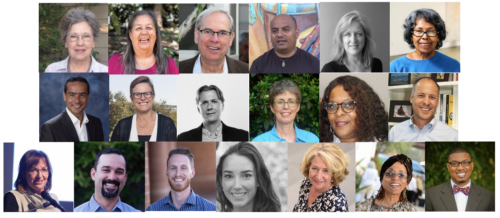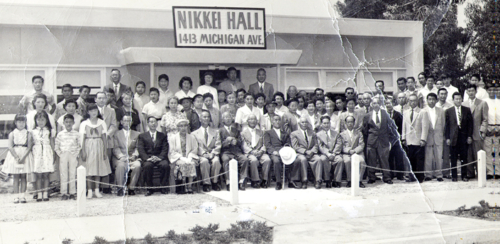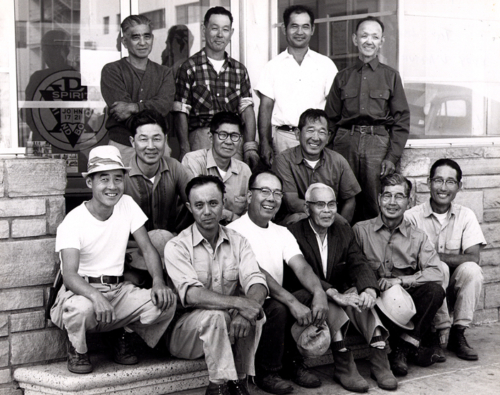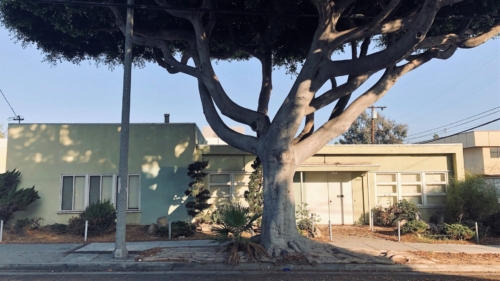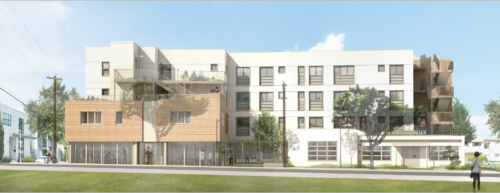With the Santa Monica Council election campaigns in progress, we thought it would interest you to see the candidates’ views on historic preservation in our city. Eight of the nineteen candidates– Phil Brock, Tom Ciszek, Gleam Davis, Mario Fonda-Bonardi, Chip Martin, Terry O’Day, Christine Parra and Ted Winterer – answered our questionnaire. Their responses are below, along with clarifying information from the Conservancy in italics.
1. What do you see as the biggest impediment to Santa Monica’s stated goal of preserving its historic, architectural and cultural resources? What obstacles or disincentives to historic preservation are you aware of?
Phil Brock: The answer is pretty simple. The WILL to preserve our 145-year history must be foremost on every city council person’s mind. That will must, in turn, be a mandate to our city staff. Our town has always spent more time in the pursuit of building mediocre buildings than preserving our history and culture. That has to change. The shift can begin by restoring the Landmarks Commission’s power to advance historic preservation. Also, the Santa Monica Conservancy must become acknowledged as a legitimate partner of the Landmark Commission and the City of Santa Monica to help identify and advance the critical work of preservation in our community.
Tom Ciszek: The biggest impediment to the preservation goals are state mandated housing growth and policy. We must balance sustainable preservation with growth and our natural resource availability.
Gleam Davis: I think that the biggest impediment to continuing Santa Monica’s preservation efforts is the lack of City funding for those efforts. Due to cutbacks that are the result of the pandemic, the City has had to reduce City staff, reduce support for the Landmarks Commission, and reduce consulting fees and other expenses connected to the City’s preservation work.
Mario Fonda-Bonardi: City Council, the City Manager and Planning Department staff do not prioritize preservation in Santa Monica for a number of reasons. First, I don’t think most of them truly understand the benefits of historic preservation for our City, including the attraction of heritage tourism, the maintenance of the character and upkeep of neighborhoods and structures, and the adaptive reuse potential in a city that is already nearly built out. Second, in light of the economic downturn, mismanagement of city funds, the pandemic and social unrest, preservation has taken a back seat. Some of these obstacles will disappear over time, but in the long run, city personnel need to be educated on the benefits in order to support implementation.
The City also needs a dedicated preservation specialist within the Planning Department staff who believes in the value of preservation and is experienced and educated in this area. To this point in time, our staff has been either laissez faire or worse, obstructionist.
Another disincentive is stripping the Landmarks Commission of its oversight on demolition permits, failing to update the landmarks ordinance, and making the Historic Resources Inventory better understood and more user-friendly.
Chip Martin:
- Developers wanting to take that land that is already planned or designated as historical
- Disincentives goes to the value of the land vs. the cost of keeping it historical. Does the city lose money by giving a property historical designation?
- Debate over the historical value of each property. I know there are guidelines, but I’m sure this is always a topic of debate
Terry O’Day: The biggest obstacle at this moment is our fiscal resources. We have been suffering through a massive economic disruption that has not finished with us. We are expecting layoffs this fall from companies that we restricted from layoffs due to federal funding. We are also operating under eviction protections in commercial and residential properties. During this time however, residential defaults have climbed from single-digits to 30% of all renters. This risks dislocation of renters at a rate not seen since the Great Depression, and commercial renters that will leave us with vacant storefronts and vacant city coffers. In times like these, historic preservation not only takes a backseat in funding, but also faces increased pressures from property owners who unexpectedly feel pressure to change their properties – fast and on the cheap. This can include wholesale demolition and replacement, but also insidious, under-detected property changes that undermine historic preservation.
The city should look for ways to identify and address these risks that do not add to our fiscal burden. Utilizing code enforcement staff, with enhanced training can help. We should be optimizing our land use ordinances to favor preservation.
Christine Parra: The biggest impediments I see related to Santa Monica’s ability to preserve its historic, architectural and cultural resources are developers and private property owners wanting to demolish all or part of historically significant properties to make way for new buildings that would yield more income. Other than the challenges noted above, I am unaware of any other obstacles or impediments.
Ted Winterer: The biggest threat to our preservation goals are the lawyers, one in particular, who are determined to eviscerate our Landmarks Ordinance. We had an unfavorable and profoundly unfortunate outcome from the litigation over the Home Savings of America building and currently are being sued over the designation of structures on Woodacres and La Mesa. And court decisions such as Woody’s have required changes to our landmarks process which have made it more challenging to apply for landmarks status.
Fortunately, the current City Council has been very supportive of historic preservation and generally votes to deny appeals of designations (I was visiting my ailing mother when the decision on the sycamore tree was rendered). So the City Attorney has been aggressively defending these assaults on our Landmarks Ordinance.
2. The City of Santa Monica is experiencing a budget crunch. Given that, what do you think the City can do, within its current means, to promote preservation and remove the impediments above? For example, are there any ordinances, policies, procedures, staffing, or programs that the City could adopt?
Phil Brock: Any fees that have been imposed by the City of Santa Monica to nominate a building or historic district must end. The community must be encouraged to participate in the crucial work of landmarking without any impediments. Even though we have a reduced budget, our city treasury is dampened but not decimated. We are currently operating at the level of city spending we had in 2013. We still spend approximately three times the amount that Los Angeles spends on each resident. We can afford to waive any fees associated with applying for landmark status. Also, the city staff should expedite applications whenever possible. The Historic San Vicente Coalition is still awaiting receipt of the ordinance that governs the district and the simple signage needed to delineate the boundaries. The wait is now five years. It shows that our city staff has not treated preservation as a priority.
Tom Ciszek: Regarding the budget crunch – to promote preservation, we must incentivize responsible rehabilitation of important resources; permit waivers and expeditious city service via digital means (e.g. process automation and zoom interviews) are two ideas that I think will help assist individuals seeking to repair and renovate in the spirit of maintaining the charm and character of our neighborhoods in a safe manner.
Gleam Davis: Until the City budget recovers somewhat, I think the most important thing that the City can do is put as much relevant information on the City’s website as possible so that members of the Conservancy and others can research the history of properties that should be preserved. Once the City budget begins to recover, the City may be able to restore some of the services that previously supported preservation of historic, architectural, and cultural resources. However, that is unlikely to happen in the next 12 to 24 months.
Mario Fonda-Bonardi: The Santa Monica Conservancy has offered its help in fashioning an updated ordinance and supplementing, where needed and appropriate, staffing gaps in preservation. Much of the Conservancy’s education programs could be made available to residents and tourists and be viewed by City Council and staff to educate themselves on what resources our City has.
The City needs to take a close look at reducing staff and excessive salaries where there is duplication of work or no longer a need. With some of the savings, more funds could be directed to implementing preservation services.
Chip Martin:
- I’m a proponent of slowing the overdevelopment of our city. The city has been giving in to large developers and it needs to stop!
- I realize we have an approx. $250 million deficit. Are there items on the Conservancy’s agenda that could be cut to help save costs to the city?
Conservancy comments: This year the Conservancy has worked closely with Council, the City Manager and staff regarding the City’s historic preservation program. We recommended which Landmarks Commission responsibilities were crucial to maintain; how the Conservancy could assist the City to reduce costs of processes that seem inefficient and/or unnecessary; and how we could increase our role to support the Landmarks Commission and the preservation program, given the reduction in staff time.
- At this time all departments in the city need to prioritize what items are most critical now and in the short term. The Conservancy needs to be flexible but hold true to properties of most significance.
Terry O’Day: I may have over-written my last response, given this question. Adding to that, we should look to a couple major projects to support historic preservation – the Miramar and Ocean Ave hotel both have significant preservation components. The Plaza on Arizona has the potential to transform that neighborhood, opening Arizona to pedestrians-only and inviting a new occupant of the very important preservation site – our Post Office. A new occupant might have a better solution for engaging the public to appreciate this building and its history.
Christine Parra: Assuming that the City of Santa Monica does not already have this in place, I would recommend as part of all processes pertaining to remodel, refurbish and demolition of properties in the City of Santa Monica, an assessment must be conducted to ensure that the property is not historically, architecturally or culturally significant and if so, the City is required to do what is necessary to preserve the property. I recognize that this approach may not be realistic but it should be important since the landscape of our beach community is ever evolving and losing its “beach” identity.
Conservancy comment: Our municipal code specifies that no property over 40 years old can be demolished without a public hearing before the Landmarks Commission to determine if the property might qualify as a landmark or structure of merit. If designated, the Commission ensures that any remodel or refurbishment meets certain standards. However, due to recent budget cuts, the City no longer has the Commission reviewing the demolition permits of these properties so monitoring these demolitions falls to the general public. In response, the Conservancy, in partnership with neighborhood organizations and others in the community wanting to be involved, is now working to identify properties that should be saved. This is particularly important for properties which represent our diverse cultural history (delete: of Santa Monica) and might not be recognized as important based on their architectural characteristics.
Ted Winterer: It’s more than a budget crunch – we had to cut $224M through June 2021 using the state’s projections that business closures would end by June 30th. Given that it’s mid-September and many of the businesses which generate 65% of City revenues are either still closed or operating at reduced capacity, we can’t count on a return to pre-COVID revenues any time soon.
So it was great regret that we had to cut the Historic Preservation Planner position so many of us had fought for before it was even filled – that would have been a great asset to our preservation goals.
However, even with limited resources we should:
- a) Evaluate early in 2021 the IZO which removed demolition permit review from the Landmarks Commission, as my motion to do so directed. We need to make sure the information and promised financial resources have been provided to the Conservancy to monitor demo permit applications and to review the legal obstacles staff cited as one reason for the change. b) Seek a status update on revisions to the Landmarks Ordinance. c) Evaluate the current virtual meetings of the Commission, is there money to allow public input by phone instead of just email? If not, can we allow for real-time email input? d) Assure development agreements for the large sites downtown are providing community benefits for preservation.
3. What direct experience, if any, have you had with historic preservation locally or elsewhere? Please describe.
Phil Brock: I was the co-chair of the Historic San Vicente Coalition. The Santa Monica Conservancy awarded the Coalition a 2016 Advocacy Award for our work in helping to birth the Historic District, which is devoted to the garden and courtyard apartments on San Vicente Blvd between Ocean Avenue and 7th Street.
Tom Ciszek: My wife and I are in escrow on a 1913 home in Ocean Park — to answer question #3. This is my first experience with historic preservation directly; however, I have experience researching preservation and the preservation of books and ephemera given my background in information and library science.
Gleam Davis: Other than my work on the Planning Commission and the City Council, I do not have any specific experience related to historic preservation. My record, however, demonstrates my clear support for preserving Santa Monica’s history as expressed in the built environment. I supported the San Vicente Courtyard District as well as the recently-designated Ocean Park Bungalow District. If re-elected, I continue to support preservation efforts as well as the transparency and integrity of the preservation process.
Mario Fonda-Bonardi: As a proud 10-year Conservancy board member, much of my direct experience has been through this organization. I was instrumental in the elongated process of saving, relocating, fundraising and rehabilitating the shotgun house and transforming it into the Conservancy’s preservation resource center. I have served as a docent trainer and an actual docent for the Center.
I was also an active participant in bringing about the designation of Chez Jay and the 11th Street Bungalow Historic District, meeting with the committee, researching, strategizing and promoting the designation.
Chip Martin:
- I was a docent at the Marion Davies Beach House from 2015 to 2017. I had to stop when a new job required some weekend hours. I’m a major history buff and loved giving the tours!
- I work in the building industry so architecture has always been a large part of my job and a major interest.
- Living downtown, I know the history of most of our historical sites and enjoy showing my friends and visitors as we walk around our great city! I could rattle them all off now but we know what they are!
Terry O’Day: My direct experience has really only been as a Planning Commissioner for seven years and councilmember for almost 11. I have learned so much from the Conservancy and its volunteers and am proud to understand how preservation works and how it benefits generations to create a more integrated, intelligent, grounded community.
Christine Parra: While I do not have direct experience with historic preservation, my love is deep for the arts and preservation of historic places. While earning a degree in Urban Studies, I had an opportunity to take classes that taught us about different styles of architecture and the importance of preserving California history. When I met my husband, we spent many weekends attending open houses of historically significant properties so I could share my love of historical places with him. This love has transcended into our married and family life with our children.
Ted Winterer: As a Councilmember for eight years I believe I have consistently voted for historic preservation. One’s memory gets a bit foggy as time passes, but in recent years I recall voting for historic districts on 11th and 4th Streets, the landmarking of John Parkinson’s home at 808 Woodacres and the preservation of 710 Wilshire.
For years I’ve kept my eyes out for things such as a seemingly illegal alteration to a building on the HRI and then alerted staff and preservationists.
And I was a dues-paying member of the Conservancy for many years, one of only two Councilmembers who joined, until the legal issues cited above required that I cancel my membership so as to be able to vote on decisions for which the Conservancy was an advocate.
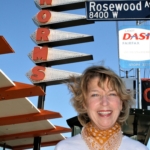 We thank Libby Motika for her service as a Conservancy Board member for the last 5 years. In addition to her contributions to the Board, Motika has been invaluable in developing architectural events and tours. She continues to volunteer as a researcher and writer as well as Program Committee Co-Chair, initiating and moderating the Summer Speaker Series and current virtual Mosaic Speaker Series. A native of Los Angeles, Motika is a journalist and served as editor of the Palisades Post for over 20 years. She is also docent with the Los Angeles Conservancy.
We thank Libby Motika for her service as a Conservancy Board member for the last 5 years. In addition to her contributions to the Board, Motika has been invaluable in developing architectural events and tours. She continues to volunteer as a researcher and writer as well as Program Committee Co-Chair, initiating and moderating the Summer Speaker Series and current virtual Mosaic Speaker Series. A native of Los Angeles, Motika is a journalist and served as editor of the Palisades Post for over 20 years. She is also docent with the Los Angeles Conservancy. The Board also welcomes new Board member Carolyne Edwards to a three-year term. A Santa Monica native, Edwards is an educator and founder of the Quinn Research Center, whose mission is to empower the community and promote the study and research of Black family history and culture in the Santa Monica Bay area. The Center was established as a tribute to the legacy of her uncle, Dr. Alfred T. Quinn, a prominent Black educator, community leader and icon in the city in the mid- to late-20th century. Edwards is also a member of the Conservancy’s 21st Century Task Force, exploring the possibilities for recognition of the former Black neighborhood on Broadway west of 20th Street.
The Board also welcomes new Board member Carolyne Edwards to a three-year term. A Santa Monica native, Edwards is an educator and founder of the Quinn Research Center, whose mission is to empower the community and promote the study and research of Black family history and culture in the Santa Monica Bay area. The Center was established as a tribute to the legacy of her uncle, Dr. Alfred T. Quinn, a prominent Black educator, community leader and icon in the city in the mid- to late-20th century. Edwards is also a member of the Conservancy’s 21st Century Task Force, exploring the possibilities for recognition of the former Black neighborhood on Broadway west of 20th Street.